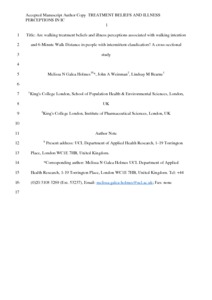Galea Holmes, MN; Weinman, JA; Bearne, LM
(2019)
Are Walking Treatment Beliefs and Illness Perceptions Associated With Walking Intention and 6-Min Walk Distance in People With Intermittent Claudication? A Cross-Sectional Study.
J Aging Phys Act, 27 (4).
pp. 473-481.
ISSN 1543-267X
https://doi.org/10.1123/japa.2018-0245
SGUL Authors: Bearne, Lindsay Mary
![[img]](https://openaccess.sgul.ac.uk/114801/6.hassmallThumbnailVersion/Accepted_Manuscript_Author_copy_GaleaHolmes_Weinman_Bearne.pdf)  Preview |
|
PDF
Accepted Version
Available under License ["licenses_description_publisher" not defined].
Download (324kB)
| Preview
|
Abstract
Intermittent claudication is debilitating leg pain affecting older people with peripheral arterial disease, which is improved by regular walking. This study evaluated associations between psychosocial variables and 6-min walk distance (6MWD) to identify factors that motivate walking. A total of 142 individuals with intermittent claudication (116 males; Mage = 66.9 years [SD = 10.2]) completed cross-sectional assessments of sociodemographics, walking treatment beliefs and intention (Theory of Planned Behaviour), illness perceptions (Revised Illness Perceptions Questionnaire), and 6MWD. Multiple linear regression was used to evaluate relationships among psychosocial variables (treatment beliefs and illness perceptions) and outcomes (walking intention and 6MWD). Theory of planned behavior constructs were associated with intention (R = .72, p < .001) and 6MWD (R = .08, p < .001). Illness perceptions were associated with 6MWD only (R = .27, p < .001). Intention (β = 0.26), treatment control (β = -0.27), personal control (β = 0.32), coherence (β = 0.18), and risk factor attributions (β = 0.22; all ps < .05) were independently associated with 6MWD. Treatment beliefs and illness perceptions associated with intention and 6MWD in people with intermittent claudication are potential intervention targets.
| Item Type: |
Article
|
| Additional Information: |
Accepted author manuscript version reprinted, by permission, from Journal of Aging and Physical Activity, 2019, 27(4): 473-481, https://doi.org/10.1123/japa.2018-0245. © Human Kinetics, Inc. |
| Keywords: |
behavior change, illness representations, walking capacity, Aged, Attitude to Health, Cross-Sectional Studies, Female, Health Knowledge, Attitudes, Practice, Humans, Intention, Intermittent Claudication, Male, Walking, Humans, Intermittent Claudication, Walking, Cross-Sectional Studies, Attitude to Health, Health Knowledge, Attitudes, Practice, Intention, Aged, Female, Male, behavior change, illness representations, walking capacity, 1106 Human Movement and Sports Sciences, Gerontology |
| SGUL Research Institute / Research Centre: |
Academic Structure > Population Health Research Institute (INPH) |
| Journal or Publication Title: |
J Aging Phys Act |
| ISSN: |
1543-267X |
| Language: |
eng |
| Dates: |
| Date | Event |
|---|
| 1 August 2019 | Published | | 13 March 2019 | Published Online | | 15 October 2018 | Accepted |
|
| Publisher License: |
Publisher's own licence |
| Projects: |
| Project ID | Funder | Funder ID |
|---|
| R477/0516 | The Dunhill Medical Trust | UNSPECIFIED |
|
| PubMed ID: |
30507272 |
| Web of Science ID: |
WOS:000481642000005 |
 |
Go to PubMed abstract |
| URI: |
https://openaccess.sgul.ac.uk/id/eprint/114801 |
| Publisher's version: |
https://doi.org/10.1123/japa.2018-0245 |
Statistics
Item downloaded times since 21 Sep 2022.
Actions (login required)
 |
Edit Item |



